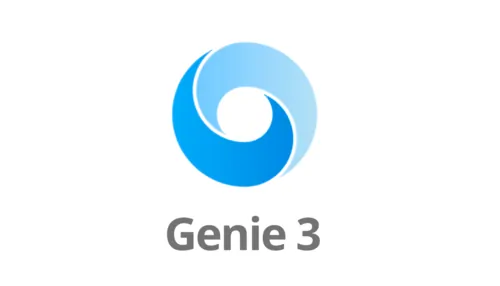Welcome to Genie 3: The AI That Creates Your Surroundings
Picture typing, a forest during a storm, then suddenly you are dropped into a live, breathing 3D world—lightning flashes, rain splatters, tree sways, and you can freely explore. Revealed in August 2025, Genie 3 is Google DeepMind's most recent innovation. It’s not only another model; it's a quantum leap in AI-powered planet simulation and an interesting move toward artificial general intelligence (AGI).
From Genie 1 to Genie 3: Origins
Let's go back a bit now. Starting with Genie 1, a research prototype that learned from unlabeled video data, DeepMind's world model voyage got started. From video prompts, it produced limited in length and dimensionality 2D "worlds" interactive.
Genie 2 (late 2024) turned the experience into 3D, yet it was still limited. Consider short bursts: 10 to 20 seconds of play, simple interactions, and scenes that shifted unpredictably over time.
Finally, Genie 3 arrives in August 2025 (officially about August 5), featuring real-time, high-resolution worlds that can sustain for minutes rather than seconds. The Verge, The Economic Times, Mediumgenie3.im.
Genie 3 can do what?
1. Real-time, high quality worlds
You name it; Genie 3 may produce fully explorable 3D environments—forest paths, beaches, extraterrestrial worlds. Delivered in real time so users may wander freely with fluid visuals, these operate at 720p resolution and 24 frames per second.
2. Minutes of consistency
Unlike its predecessors, Genie 3 preserves your reality throughout time. Leave and come back; now the setting, items, even brush strokes stay where they were. This is made possible by its emergent tenacity and brief visual memory of up to a minute.
3. Promotable Global Events
Should you want a sudden rainstorm or maybe may be include a flock of bird’s midway scene? Simply write it. On the fly, without having to restart The Genie 3 lets you dynamically change weather, produce items or characters, and remodel the surroundings.
4. Physics by learning, not programming
Ignore conventional physics engines. Through instruction using vast amounts of video material, Genie 3 came to comprehend gravity, item motion, fluid dynamics, and lighting. This offers emergent, realistic physics without any scripting required
Essentially, Genie 3 uses autoregressive world modeling to combine visual memory, real-time engagement, and learned physics. Genie 3 creates each frame by interpreting your actions and preceding events, therefore constructing a consistent experience throughout time.
The Need: Applications and Consequences
• Research on AI training and AGI
Genie 3 is not only amazing to investigate; it's a playground for AI itself. Embodied agents (think robots or virtual assistants) may train, study, make mistakes, and change in highly different situations without any real-world danger. This is a forceful direction for AGI development.
• Development of games and interactive media
Picture semiauto generated universes prepared for game prototypes or narrative. Designers might live inside their concept in words right now. Early collaborations with companies like Epic Games or Unity point to 70 to 80% reductions in prototype cycles .
• Learning and Education
Early pilots (e.g. at Stanford) saw notable improvements in spatial reasoning when pupils could "walk" through their creations rather than simply watch them; all made from basic prompts. Students could explore recreated historical cities, traverse molecular worlds, or view natural occurrences.
• Film and previsualization
Directors could describe a dramatic scenario in words and immediately jump into it testing camera angles, lighting, and staging without constructing elaborate sets. Good for creative investigation even if images aren't yet of final production quality.
Knowing Its Bounds
Genie 3 even has certain limitations. Currently, it is only accessible as a research preview limited to certain academics and designers
Certain constraints still exist:
• Interaction horizon: Minutes, not hours. This isn’t an endless open world yet
• Multi-agent complexity: Simulating lots of characters simultaneously is still a challenge
• Real-world accuracy: Genie 3 isn’t meant to faithfully recreate precise geography or render legible, readable text inside scenes unless explicitly prompted
• It's designed for exploration and AI testing, not final visual fidelity or consumer release—for now.
A Look into the Future
Genie 3 already seems to be entering the next age of AI creativity and simulation. Still, what is next?
Expect:
• Wider access beyond academia, maybe via APIs or inventive platforms.
• Longer interaction spans, approaching hours or even ongoing world persistence.
• Better multiagent support allows NPCs, simulations, or player crowds.
• Higher visual fidelity, possibly even reaching into photorealistic or 4K domains.
From static videos to dynamic, interactive artificial intelligence worlds, this development represents a major change in human-machine cocreating of experiences. If you start creating worlds as simply as you write stories, you shouldn't be surprised.
In Sum
Genie 3 is not just an AI model; it's a gateway, a portal into interactive, persistent worlds developed at 720p and 24 fps that remember your actions and react to fresh commands—all powered by learning, not manual scripting. Its where artificial intelligence invention meets creative, instructional, and inquisitive exploration.
Genie 3 opens the door—and invites you to walk right in whether you wish to train sophisticated artificial intelligence agents, prototype games at lightning speed, instruct pupils via immersive worlds, or simply pilot through your imagination.









Write your comment